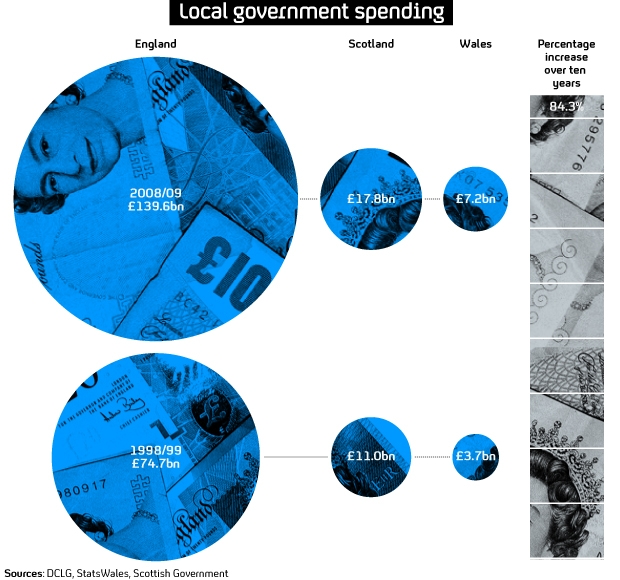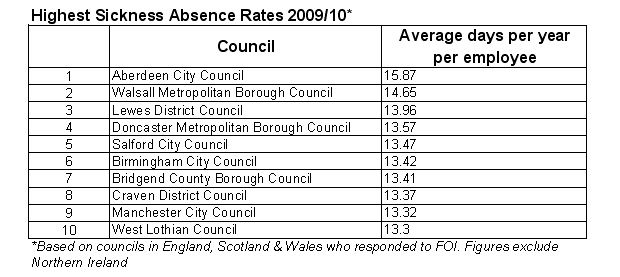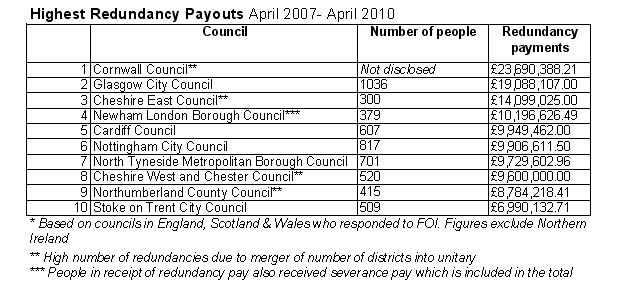Exclusive: council spending revealed ahead of cuts
Councils spend millions on sick days, redundancy payouts, and incentives to get staff to come to work including fruit baskets and M&S vouchers, a Channel 4 News investigation discovers.

Councils are facing unprecedented budget cuts of 28 per cent by 2015, with an estimated 100,000 job losses in the next five years.
For the last nine months, Channel 4 News and the Bureau of Investigative Journalism have been carrying out the largest ever Freedom of Information request into local councils, to find out exactly what they’ve been spending our money on, and how they’ll be able to slash their budgets by over a quarter.
Spending by local government in England, Wales and Scotland has risen 84 per cent in the past ten years, to over £160bn a year. But this decade of plenty has come to an abrupt end – the government announced last month that they will be slashing council funding by 28 per cent over the next five years.
The graphic (below) shows just how much local government spending rose in the last decade: from around £90bn in 1998/1999 to more than £160bn in 2008/2009.

So how have councils been spending our cash? And will such huge savings actually make them more efficient, as the government is hoping?
Sickness Absence
Our investigation found that many councils face a very costly problem – employees take over a third more sick days than their counterparts in the private sector.
Our research reveals that, of the councils that responded to our FOI request, one in five councils in England, Scotland and Wales reported an increase in sickness levels of over 10 per cent in the past five years. On average, councils lost 9.4 days per employee in 2009/10 due to sickness absence. This compares to an average 5.8 days in the private sector, according to a report in June this year by the Confederation of Business Industry.

The overall sickness rate for councils is marginally lower than five years ago but there are still some councils with startling levels of illness. Topping the table of those councils that responded to our queries is Aberdeen City Council where workers are off sick for over three weeks a year on average – 15.9 days per employee.
Sue Bruce, Chief Executive of Aberdeen City Council, told Channel 4 News that environmental factors such as the harsh winter, and the recent turbulent history of the council were partly to blame.
Ms. Bruce doesn’t deny that it is a big problem for the council and she estimates that staff absence costs the council up to £5m a year. But, she says, they have introduced new measures to combat the problem which are showing improvements already, and they have now dismissed 25 workers over sickness absence issues.
She said: “The new management team and the new culture we’re embedding here is making a difference. Over the course of the last 12 months we have actually improved by an average of one day, so it’s gone from 15.9 to 14.8 over the last several months.
Council workers do face a lot of uncertainty around their jobs…That does cause a lot of stress and strain. GMB union regional officer for Aberdeen, Janet Adams.
“It’s [still] not acceptable at that rate, but we’re satisfied that the measures that we’re putting in place, which complement all of the governance and accountability measures we’ve put in over the last 18 months or so, are generating improvements across the board – in financial management and performance management, and, as we see gradually, into absence management.”
Last week Aberdeen City Council announced £127m of budget cuts over the next five years. Janet Adams, GMB union regional officer, said the threat of job losses will lead to more stress on the workforce, meaning sickness absence levels are likely to increase or stay the same between now and next February, when the cuts are announced.
She said: “Council workers do face a lot of uncertainty around their jobs. With job cuts for the past three years and continuing for the foreseeable future until they get more money from central government. That does cause a lot of stress and strain.”
Consultant Stephen Taylor, who has advised the government and councils on efficiency and remuneration, said: “Sickness absence is actually quite a good measure of the ability to manage people, it’s 40 per cent higher in local government than it is in the private sector and they need to act on that, there’s no excuse for that.”
Sickness absence is…40 per cent higher in local government than it is in the private sector, and they need to act on that, there’s no excuse for that. Stephen Taylor, consultant who has advised the government on efficiency.
John Ransford, chief executive of the Local Government Association (LGA), the membership body for English and Welsh councils, said that some councils do need to manage sickness absence better.
He said: “Sickness in councils has been coming down over the years – it’s been getting better but it certainly doesn’t compare with best practice in the private sector. Some jobs are incredibly stressful – child care work certainly, given the microscope it’s been placed under in recent years – and work with the elderly…
“But sickness needs to be managed – we need to be far sharper on the reasons why people are off – interviewing when they come back – to look at their sickness, to say that work is the important thing, continuity of work and sickness must be managed very carefully. And there is no doubt we need to get far better at that to use our resources more effectively.”
Incentives
Our investigation highlights the lengths some councils will go to in order to encourage employees to turn up to work.
We have discovered that 25 councils have offered prizes to staff with perfect attendance, ranging from financial bonuses to Marks & Spencer vouchers or extra days off.

Conwy County Borough Council, in Wales, ran a one-off prize draw in 2008, offering bikes, fruit baskets and a step machine – at a total cost of £673.61.
Just up the coast, Fylde Council, in Lancashire started a “100 per cent attendance club” last year, with a draw for M&S vouchers, certificates for all staff and refreshments, to a total value of £350.
Other councils offered workers extra days off. For example Liverpool City Council awards two additional days’ leave after 12 months of non-sickness. All of the councils we approached told us that these incentives were just one part of a wider strategy for managing sickness rates. But other local authorities told Channel 4 News they were against the idea of prizes for coming into work.
Eastleigh Borough Council said: “As staff we are paid to attend work; that should be incentive enough.”
And Chichester Council told us: “We do not incentivise staff for their attendance as schemes like that have been described as discriminatory and divisive.”
Private Healthcare
Our research shows, though, that some councils go even further to keep their employees fit for work, raising questions as to whether councils have been making the best use of taxpayers’ money.
In fact, our FOI has discovered that 56 councils spent over £2.9m last year on providing private medical insurance for over five thousand employees.

Local Government Association (LGA) Chief Executive, John Ransford told Channel 4 News: “The provision of private health care only exists in a very small number of authorities – mainly in London and the South East. Over the years it’s been one of the things thats been introduced as a staff attraction and retention issue.
“We’re coming out of a period of economic prosperity where councils were competing with other people for staff and it was one of the measures used. Now, these councils will argue that it helps keep their workforce fitter – gets people back to work quicker if they suffer a major injury or illness – but it is not a major factor in local government generally across the country. And it’s up to each local authority to determine its own priorities and conditions for its workforce.”
Redundancy payouts
But spending on staffing has soared in the past decade showing an increase of 78 per cent in council expenditure on employees. Local authorities have recognised this and, according to our Freedom of Information request, they have reduced staffing levels by 30,000 over the past 3 years.
But it costs money to make people redundant and, while there is a national statutory minimum paid to laid off people, Channel 4 News has discovered that some councils pay out rather generous redundancy and severance terms to their staff.
For example, the London Borough of Newham has spent just over £10m pounds on redundancy and severance since 2007 laying off 379 staff – an average payout of £26,904 per employee. Workers in the private sector receive an average payout of just £9,000 – a third of what Newham has paid out.
A Newham Council spokesperson told Channel 4 News: “We have saved £68m over three years and we expect to save almost £140m in total by the end of 2014. We have the lowest council tax in outer London and there has been [a] zero percent increase for the last two years.”

Glasgow City Council, which spent £19m laying off 1,036 staff, told Channel 4 News: “Glasgow has one of the highest total values for redundancies because we have let the most people go; however, given that this is one of the biggest local authorities in the UK, with an annual budget of around £2.5bn, that’s not surprising.”
The council said that 9,000 employees were transferred off the council payroll last year when a department was turned into a limited liability partnership.
But, even for more frugal councils, the future is stark when it comes to funding staff cuts.
Sheffield City Council has already made 500 staff redundant at a cost of £4m. But they could face further staffing cuts of up to 1,500 staff.
Councillor Paul Scriven, leader of Sheffield City Council, told Channel 4 News that the council has £5m in reserves to deal with future redundancies but he does not deny that the council may have to find money from elsewhere to foot a much larger bill.
“If we haven’t got enough sitting in reserves in the first few years we’ll have to look at how we are allowed to use our resource to put more into reserves,” he said.
The LGA agrees that this is a problem for councils.
“There is a rock and a hard place here in that staff are expensive to employ and because of the way redundancy works, it’s expensive to bring careers to an end in that way,” said John Ransford, Chief Executive of the LGA.
A lot of local authorities are good…but in some clearly they’ve got out of hand. Lord Wills, former Labour MP and Government minister.
“Now, councils have been planning for this. One of the reasons why councils have reserves in expenditure is precisely to pay for this sort of situation. All the time they must balance the cost of reducing staffing levels against the cost of providing services, because the public’s expectations won’t change just because the resource base changes, and a lot of our services – like care of older people or carers of young children – they don’t reduce simply because the economy changes.
“In fact, you could argue the other way – because economic circumstances are difficult, there are more demands for those services.”
Lord Wills, a former Labour MP and Government minister, said: “I think what that reveals is a lack of adequate governance with local government. A lot of local authorities are very good, they’re parsimonious, they’re decent, honest, honourable people doing their best for the people that they serve, but in some clearly they’ve got out of hand, and what I think this reveals overall is that the system of governance for local government needs to be reviewed.”
Glasgow City Council statement:
Glasgow City Council is one of the biggest local authorities in the UK with an annual budget of some £2.5bn.
The council has led the way with a substantial and radical service reform programme over the last few years and as a result has saved tens of millions of pounds.
For example, setting up arm's-length organisations has generated one-off income of £160m for the council and they save us £23m every year.
Much of the public sector is now looking at the work we have been doing as the scale of the financial challenges becomes clear.
Foreign Trips
In all, councils spend £4.5 million on foreign travel over the last four years, going on 5,457 trips in total. One third of councils spent more on foreign travel in 2009/10 than they did in the previous year, despite the recession.
Kent County Council took a total of 117 foreign trips in 2009/10, costing £56,044.84. Deputy Leader of the council, Alex King, said: “The aim of all Kent County Council’s international activity is to enhance the services and support for our residents. KCC is one to the leading authorities in the UK at using its influence to maximise EU programmes.
“Since 2007 the authority has helped to secure £21.4 million in EU funding grants for Kent. This funding has been obtained as a direct result of developing links with European partners and has been used to support economic development, regeneration, tourism, environmental protection and education and training for the county.
“The aim of all Kent County Council’s international activity is to enhance the services and support for our residents.”
Alex King, Deputy Leader of Kent County Council
“Kent is the only fixed link to mainland Europe and is a global gateway region, offering a range of opportunities and challenges. Kent County Council develops and maintains strong international partnerships to benefit the county by increasing tourism, trade and inward investment; by securing the benefits of major events such as the 2012 Olympics; by raising the county’s profile as a place to live and do business; by giving our young people access to international culture and learning; and by maximising European funding coming into Kent.”
Sunderland City Council spent the most on trips last year, with 41 trips costing a total of £82,228.87. These included seven trips to Washington DC, costing £27,799.31. Sunderland City Council told The Bureau of Investigative Journalism that the foreign trips brought numerous benefits, including 8,250 new jobs and investment totalling £1.5bn from overseas in the last five years.
-
Latest news
-
‘I violated my moral compass working for Trump,’ former lawyer testifies3m

-
Working class creatives in film and TV at lowest level in decade5m

-
Israeli police investigating attack on Gaza aid convoy4m

-
Biden announces major tariff increase on Chinese-imported green tech3m

-
‘If NHS can afford it, people with obesity should have Semaglutide,’ says weight loss expert5m

-




